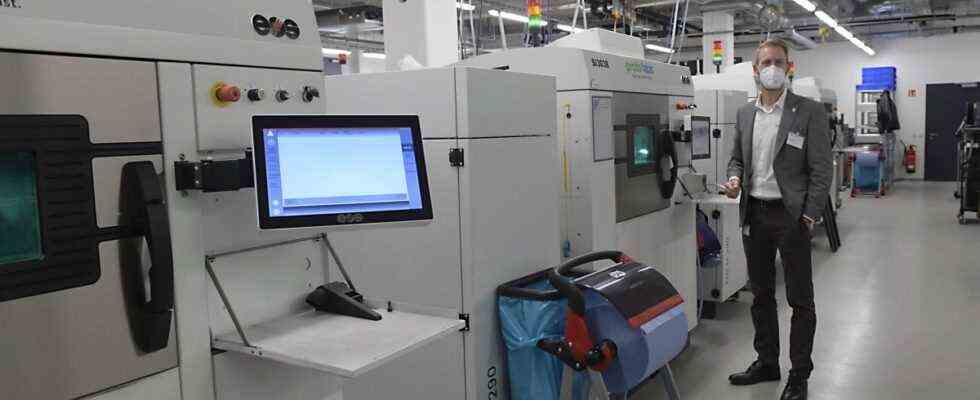In 3D printing, machines apply metal or plastic layer by layer. This is how three-dimensional objects are produced, from the prototype of an aircraft turbine to dental prosthesis products, complex objects are created based on a digital template. The US company Protolabs operates production facilities at nine locations around the world. She opened a new factory in Putzbrunn. Robert Bodor is the President and Chief Executive Officer of Protolabs. Björn Klaas is Vice President and Managing Director responsible for Protolabs in Europe and the Middle East
SZ: Mr. Bodor, Protolabs could not only have moved into its European headquarters in the Munich district. Why did you choose Putzbrunn?
Robert Bodor: We already had a branch in Feldkirchen and wanted to avoid our employees having to travel long distances or having to move to the new factory. We also feel at home in the region and appreciate it for its industrial strength.
Björn Klaas: Infrastructure and logistics also came in very handy here. Over the past ten years Munich has developed into a hotspot for 3D printing in Europe, many of the big players in the business are based here. As this factory focuses on our 3D printing business, the location was obvious.
Robert Bodor, President and CEO of Protolabs.
(Photo: Claus Schunk)
What role does this new location play for Protolabs?
Bodor: All of Europe is supplied from Putzbrunn, Great Britain included. Putzbrunn is also responsible for the Middle East. Here we use several different 3D printing processes. Injection molding and CNC machining are located elsewhere.
Medical technology, automotive and aviation industries are strong branches of the economy in the district. Who is one of your customers or should you soon become your customer?
Bodor: We work with engineers from a wide variety of industries. The automotive and aerospace industries are particularly important in the European business. That was definitely a factor in the choice of location.
And what about the customers? What customers do you have?
Bodor: We only talk about some customers because in prototype development we have to make sure that no sensitive information about our customers’ competitors gets through.
Klaas: Our customers include large automobile manufacturers and suppliers, but also well-known medical technology and electronics companies.
Bodor: We work with companies of all sizes. From startup founders to listed Fortune 500 companies.
Björn Klaas, Vice President & Managing Director of Protolabs.
(Photo: Claus Schunk)
What is required of your employees and what can the employees at Protolabs in Putzbrunn expect?
Bodor: We have high security standards here and therefore also have a good security record in the company. In addition, further training and opportunities for advancement are very important to us. We want our employees to stay with the company for a long time.
Klaas: Many of our employees are career changers. Everyone should learn from everyone with us.
How difficult was it to plan and construct this building? Did you get to know the perils of the German bureaucracy?
Klaas: In retrospect, it only took about three years from the moment we made the decision to build to the opening. And that despite the corona pandemic, interrupted supply chains and workers in quarantine. We can’t really complain about that.
Their goal is to grow sales to over a billion dollars. How are you going to do it?
Bodor: On the one hand, we want to remain among the global market leaders in 3D printing. We are the fastest manufacturer worldwide in many areas of application. Delivering components in just one day is what sets us apart. In January we took over the Amsterdam-based company Hubs: a digital network of production partners that complement our in-house manufacturing capabilities. We want to lay the foundation for our growth with the world’s most comprehensive range of digitally supported contract manufacturing.
Can you reach the billion-euro target with priority prototype production?
Bodor: Over time we produce more and more end products. It was customers who discovered us to manufacture finished components and we responded to this demand. Today, at least in the classic injection molding process, more than half of our production has nothing to do with prototypes. And 3D printing is also developing in this direction. Especially when printing with metal there are a lot of finished parts. Components printed by us have already flown into space.
Will 3D printing make the leap from producing prototypes to mass production?
Bodor: We firmly believe in it.
Klaas: In the last ten years, thanks to new technologies, we have left some of the teething troubles of 3D printing behind us. A few months ago, Porsche developed a new transmission for a new electric car. Typically, these gears consisted of at least ten to 20 parts. Porsche combined all of this in one part using 3D printing and saved 40 percent weight. Such a gear can only be printed, not milled. In particular, where 3D printing enables more than conventional manufacturing technologies, it is facing the transition to a full-blown production technology.
Prototypes and components were manufactured even before Protolabs. What is the difference to your production?
Bodor: We can help get products to market much faster. For example, Johnson and Johnson told us that we had cut their development process by six months. We also work without a minimum order quantity. This is good for small startups with a low budget and has advantages in repair work because we can no longer produce single items that are no longer manufactured. Our customers can also tailor their production to demand because we are so flexible in production. The world is currently navigating through the biggest disruption in global supply chains to date and demand is fluctuating like never before. We can adapt to these conditions and produce accordingly.

